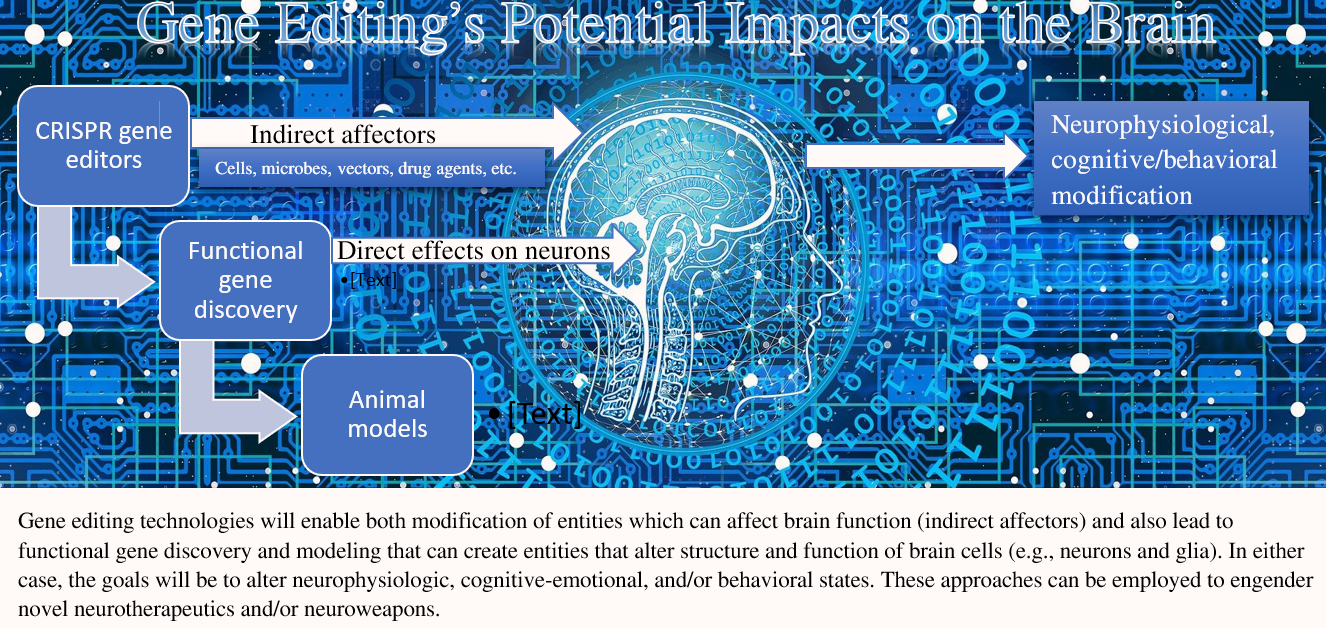
Janus, Roman god of gates, doorways, beginnings, and endings, and Bellona, Roman goddess of war. Sculpture by Johann Wilhelm Beyer, 1773-80 CE, Vienna, Schönbrunn Garden.
Why Gene Editors Like CRISPR/Cas May Be a Game-Changer for Neuroweapons
“This year marks the Eighth Review Conference (RevCon) of the Biological Toxins and Weapons Convention (BWC). At the same time, ongoing international efforts to further and more deeply investigate the brain’s complex neuronal circuitry are creating unprecedented capabilities to both understand and control neurological processes of thought, emotion, and behavior. These advances have tremendous promise for human health, but the potential for their misuse has also been noted, with most discussions centering on research and development of agents that are addressed by existing BWC and Chemical Weapons Convention (CWC) proscriptions. In this article, we discuss the dual-use possibilities fostered by employing emergent biotechnologic techniques and tools—specifically, novel gene editors like clustered regular interspaced short palindromic repeats (CRISPR)—to produce neuroweapons. Based on our analyses, we posit the strong likelihood that development of genetically modified or created neurotropic substances will advance apace with other gene-based therapeutics, and we assert that this represents a novel—and realizable—path to creating potential neuroweapons. In light of this, we propose that it will be important to re-address current categorizations of weaponizable tools and substances, so as to better inform and generate tractable policy to enable improved surveillance and governance of novel neuroweapons.
The authors discuss the dual-use possibilities fostered by employing emergent biotechnologic techniques and tools—specifically, novel gene editors like clustered regular interspaced short palindromic repeats (CRISPR)—to produce neuroweapons. They posit the strong likelihood that development of genetically modified or created neurotropic substances will advance apace with other gene-based therapeutics and assert that this represents a novel—and realizable—path to creating potential neuroweapons.”
[…]
“In the interim, it is likely that more indirect means of manipulating the brain and behavior will be developed. ‘‘Neurohacking’’ will increase, and biotechnology, such as CRISPR/Cas and novel gene editors, will provide tools to realize production of novel neuroagents with dual-use po-
tential. Simple acknowledgment of these facts, however, is insufficient. It will be essential to pursue and obtain a deeper and fuller understanding of the ways that genetic pathways to human cognitive and behavioral modification can be engaged for dual and direct use as neuroweapons, to
formulate policies based on this level of understanding, and to engage surveillance of the use of these technologies in various silos of development and application, so as to afford both preventive and more preparatory capabilities.”
Plain numerical DOI: 10.1089/hs.2016.0120
DOI URL
directSciHub download
Show/hide publication abstract


Janus and his two faces: past and future.
“There is a scientific race for decoding the human brain. current and near future technology will make it possible to not only merely influence the enemy’s mind and behavior, but to actually control it. breakthroughs in neuroscience will enable new types of non-lethal weapons for precise behavioral manipulation, for example through behavior-altering neurotropic drugs, through remote electromagnetic brain monitoring and stimulation, through acoustic weapons beaming voices directly into enemy heads, and even through holographic projections and other ‘complex battlefield illusions.’ within ten years soldiers could be equipped with transcranial magnetic stimulation devices or brain-computer interfaces, which would make it possible for their commanders to steer their emotions and to control their thoughts. this paper will discuss how the emerging sixth domain of warfare (the mind) is likely to transform military operations and profoundly change how wars are conducted. it is argued that military operations will be increasingly centered on achieving desired psychological effects, which will, on the positive side, reduce the need for physical destruction and killing. at the same time, ‘neuroweapons’ will also create new and unprecedented dangers, resulting from misuse and proliferation, which will need to be addressed through development of a concept of ‘neurosecurity’ that will be outlined.”
Show/hide publication abstract

Further References
Plain numerical DOI: 10.1057/s41292-018-0121-4
DOI URL
directSciHub download
Show/hide publication abstract
Plain numerical DOI: 10.4324/9780429447259-6
DOI URL
directSciHub download
Plain numerical DOI: 10.1057/9781137381828
DOI URL
directSciHub download
Show/hide publication abstract
Plain numerical DOI: 10.1057/9781137381828_6
DOI URL
directSciHub download
Show/hide publication abstract
Show/hide publication abstract
Plain numerical DOI: 10.1057/9781137381828.0013
DOI URL
directSciHub download
Show/hide publication abstract
Plain numerical DOI: 10.1093/lril/lru009
DOI URL
directSciHub download
Show/hide publication abstract
Show/hide publication abstract
Plain numerical DOI: 10.31374/sjms.86
DOI URL
directSciHub download


